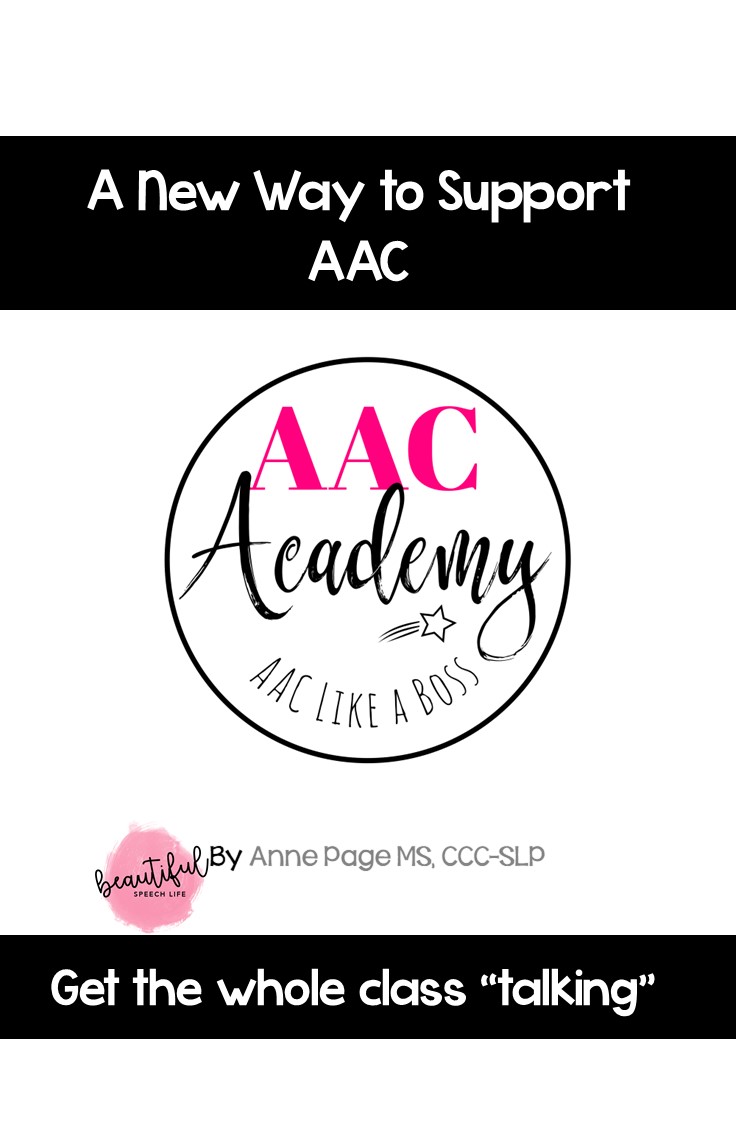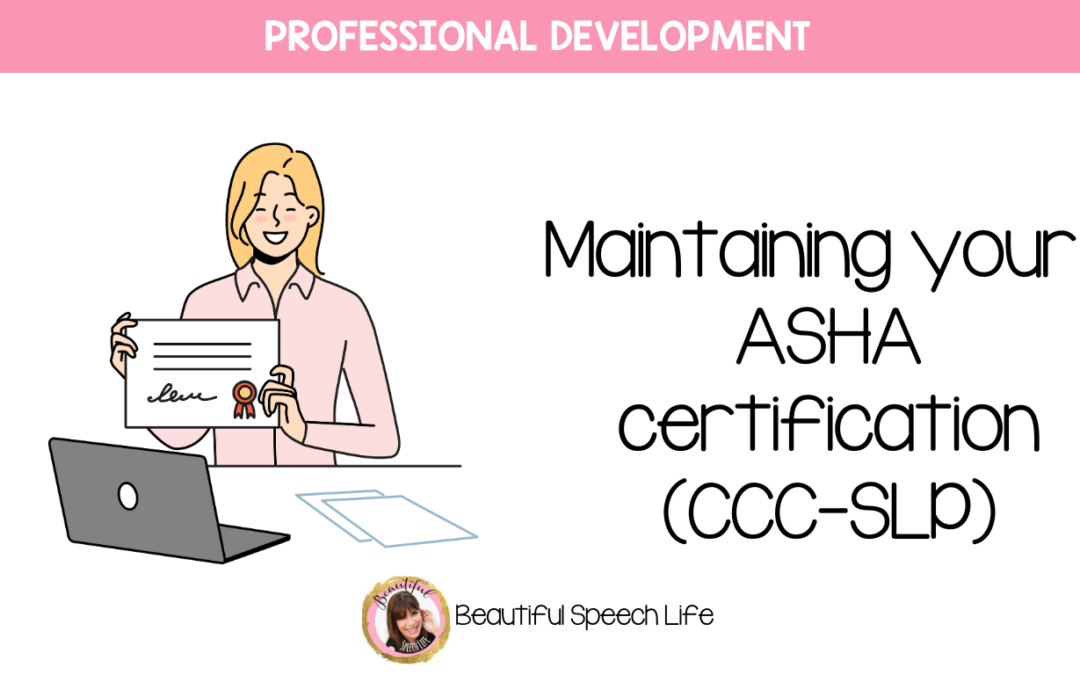
by Anne Page | Oct 29, 2023 | SLP Like a Boss
Maintaining your ASHA certification (CCC-SLP) is one of the ways we demonstrate as speech language pathologists, our commitment to supporting our students. If you have an ASHA Certificate of Clinical Competence (CCC-SLP) then you’ll know that to maintain this ASHA Certification you’ll need to accumulate 30 Professional Development Hours (PDHs) during each 3-year certification maintenance interval. You can read the requirements here on ASHA website. You might also see people talking about CEUs
1 PDH = one hour = 0.1 ASHA CEUs
10 PDH = ten hours = 1.0 ASHA CEU
There are also new requirements that at least one hour must be in the area of ethics and at least 2 hours must be in cultural competency, cultural humility, culturally responsive practice, or diversity, equity, and inclusion (DEI). The ASHA website has all the details.
But what can you do to meet these requirements?
AAC CEU courses
These are activities that have been preapproved by ASHA and you can sign up for the ASHA CE registry to track your hours. Once you’ve reached the 30 hours then your compliance form will be automatically submitted. If you are selected for a maintenance audit then you aren’t required to show evidence or report your activities.
CEUs and the registry are very convenient but what’s kind of confusing is how they’re calculated.
Here are some places where you can find free ASHA CEUs and paid PDH (previously called CMHs)
- ASHA’s website offers a variety of free CEUs, including webinars, podcasts, and articles.
- Many universities and colleges offer free CEUs to their alumni.
- There are also a number of professional organizations that offer free CEUs to their members.
- Finally, you can sometimes find free CEUs by attending conferences or workshops.
Please note that not all free CEUs are created equal. Some may be more valuable than others, so it’s important to do your research before you sign up for any.
Professional Development Hours (PDH)
Professional Development Hour (previously called a certification maintenance hour or CMH). The benefit of PDHs is that they don’t have to be ASHA-approved. (Check here) Just stick with this list and you don’t need to check with ASHA. You will need to keep track of these hours on your own and be able to provide verification of participation if audited.
The list is broad and includes business and management courses and teacher-oriented content as well as activities more directly linked to speech, language and hearing.
My favourite AAC training for SLPs
One of my favourites is the AAC Institute’s Introduction to AAC which is available here. This course is aimed at people who are new to using AAC and includes looking at what AAC is, identifying AAC stakeholders and classifying AAC interventions.
Saltillo is another great place to find courses. They not only provide training on using their products like Touchchat and Lamp Words for Life but also short courses on implementing these products. Some of their courses are registered for CEUs but not all. You can find out more about their training here. If you go to their implementation classes many are available for free free CEUs.
If you are looking for more hands-on-support and a community to learn with then I would love to see you in my AAC Jump Start Intensive Course. It’s the only course that will:
- Provide you with AAC coaching and support
- Give you the immediate tech knowledge you need
- Provide immediately actionable ideas and strategies
- Give you a crystal clear AAC roadmap to build your confidence.
Get all the details here and join the waitlist. On completion we can give you a certificate of completion for your records.
Maintaining your certification can feel onerous but it doesn’t have to be. There are so many great resources out there to help you develop your skills and become an even stronger partner for your students and their family.
Pin to read later:
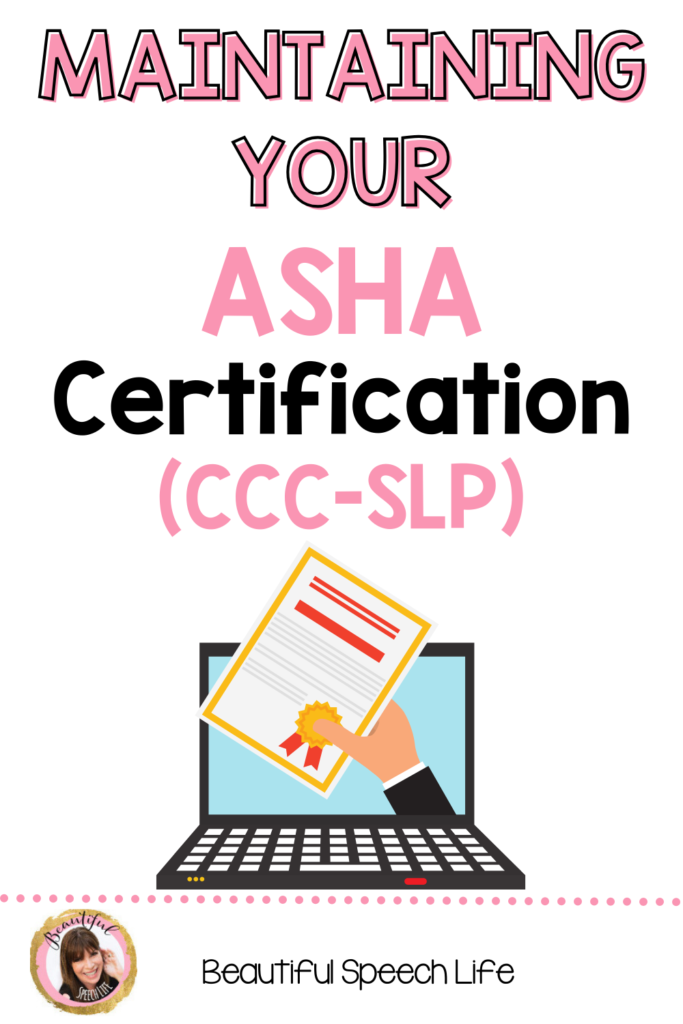
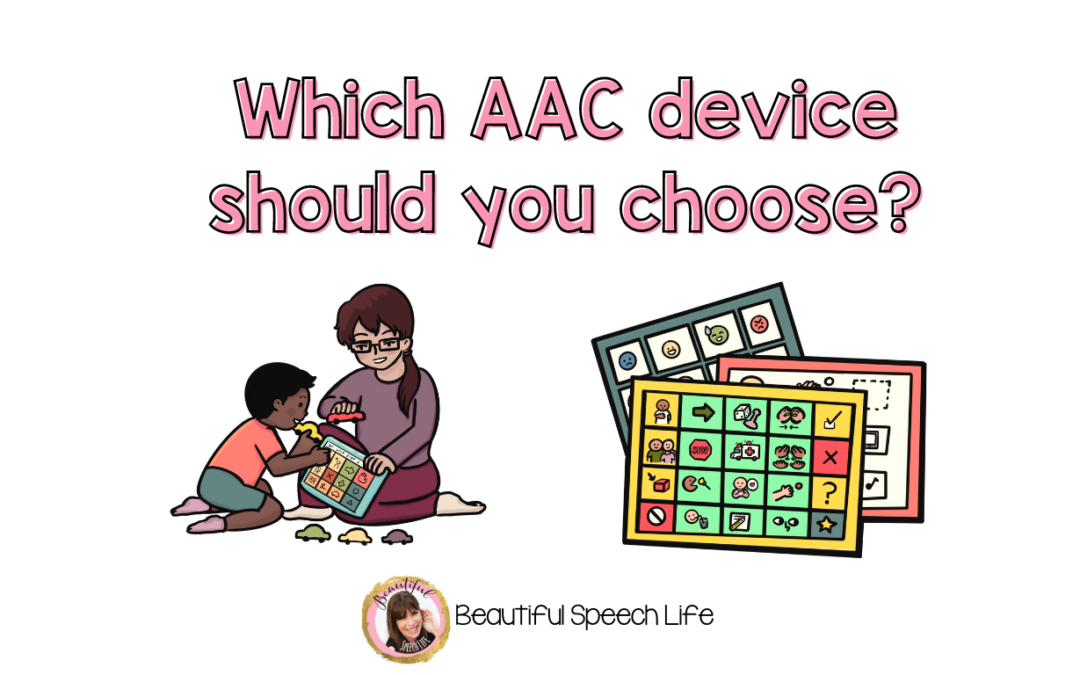
by Anne Page | Sep 23, 2023 | Ipad Apps, Technology, Therapy Materials and Ideas
I get a couple of questions all the time:
- Will using AAC delay my child speaking or mean they never speak at all?
- What device should I get?
To answer the first one, that is a definite no! I have witnessed the opposite, where having a communication board gave the student the foundation to build their speech. And kids are speaking more because we’re giving them this visual language – they hear something and connect it with a picture and a pattern. They’re able to have that multimodal communication by touching the device, hearing the device speak and having the communication partner speak. There is evidence to support that early implementation of AAC can help in the development of language and natural speech (Romski et al. 2010)
We want to prioritize communication over speech production.
The next question about what device isn’t so easy to answer. It will depend on the child and their preferences.
No matter which AAC device we choose, I start with core vocabulary.
Physical access
We choose the system that a student can physically access. I work with the physical therapist to make sure that we’ve got the position right. I work with the occupational therapist to talk about things like how far the student can reach or whether they can isolate a finger. From there, we choose our field of core vocabulary words. It’s up to us to model those words as often as we can, in a functional way.
I want to model those core vocabulary words during something that’s of interest to the child. We’ll pick a fun activity and a couple of core words that go with it. If a child is farther along, I would give them a device like an iPad that has TouchChat, a communication app, on it. The app can help make predictions for students based on what they click on and where they want to go.
There are bigger devices that have a keyboard. For assessment purposes, a device like that would help a student who can spell. For other students who might just use a few symbols, I think we have to consider their language ability and their communication ability. And whether the student can answer questions and/or how they answer questions.
Some students have an eye-gaze based device that’s funded through insurance, but it can be difficult to get staff to support that because they’re scared they are going to break it or do something wrong. But those devices are amazing!
Students with Cognitive Visual Impairment (CVI)
You may have students Cortical Visual Impairment (CVI). We show them a core board and all the symbols we show them end up being all mushed together. We’ve learned that it helps to use a black background and make the symbols yellow or red. And then we’ll partner with the student’s vision teacher. With all of the kids, we use core vocabulary as our foundation. When they learn that word in school, that word will mean the same thing everywhere. We choose the power words to focus on for that. And then depending on the student, we customize their high-tech or low-tech boards or switches.
Watch how we created a high/contrast AAC communication board on this Instagram video.
Bilingual Students
If we know that a student is bilingual then we’ll choose an app like LAMP Words For Life, which is English/Spanish – and it’s just one button to press to switch back and forth between the two languages.
English Language Proficiency
For students who convey understanding and communication through an image we may want to work with them on their English language proficiency. With a keyboard, there’s word prediction (if you have it enabled – maybe turn it off for a spelling test) when you start to spell something. The thing to consider about AAC is it’s so slow. Anything we can do to make it faster. That’s what’s so great about word prediction – a student types in a few letters and it will bring up a lot of choices.
There are no hierarchies in AAC
Starting with a low tech printed core board is often an easier way for families to get started with AAC in a low cost way. But if a child isn’t interested in the core board, they don’t need to “pass it” to move onto high tech.
There are no prerequisites to move onto high tech. It’s more important to consider each child’s needs and preferences. If you have access to high tech and the student is showing interest in the high tech device and you have access to it then it would be a great idea to try it.
Next Steps
If you are ready to get started with using AAC then head over here to read my 6 strategies for getting started with AAC.
Looking to find out more about AAC? Learn more about my experiences with AAC in my interview with WIDA.
Pin to read later:
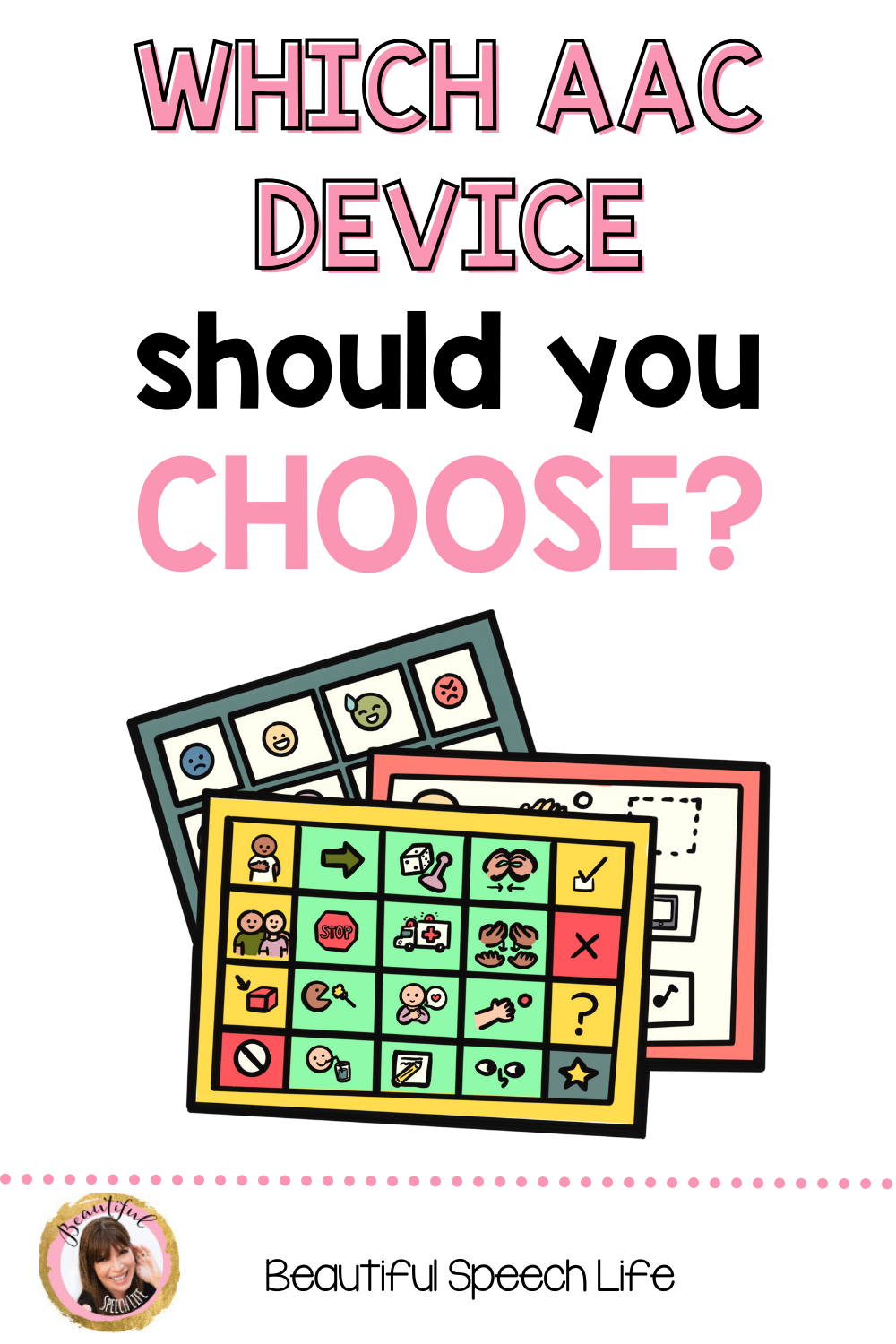
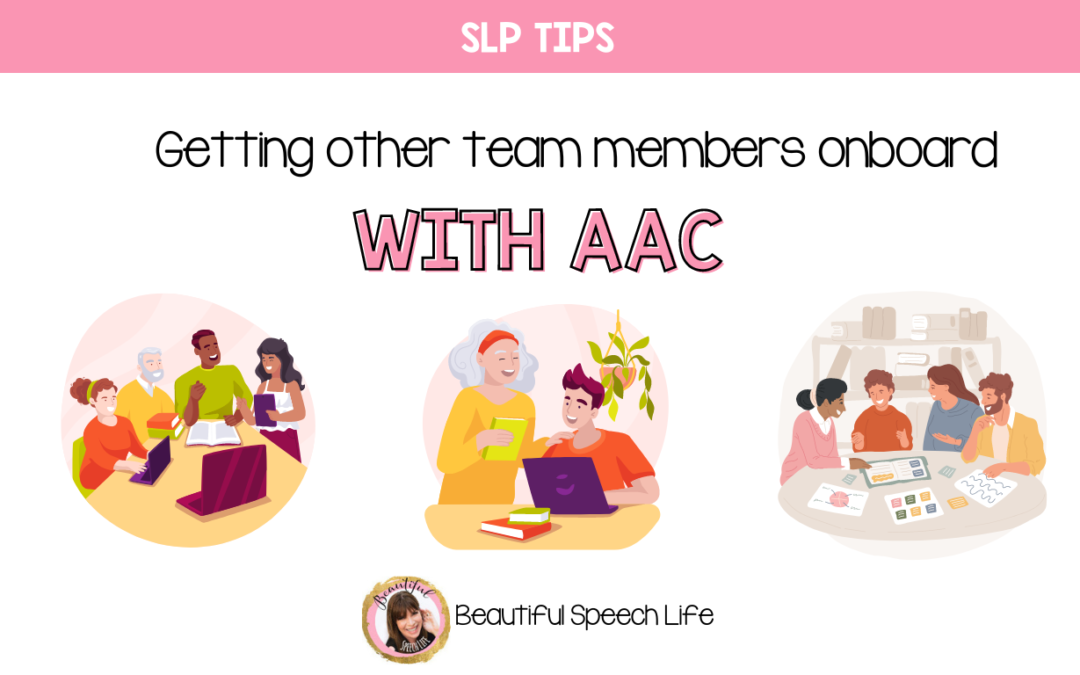
by Anne Page | Sep 17, 2023 | Quick Therapy Tips for the SLP and SLPA, SLP links, TPT Products
We can do fantastic work with our students using AAC but as I’m sure you know AAC is something that has much more impact if it is happening everyday. Which means we need to get colleagues at the school onboard with supporting students with their devices and other resources. But getting other team members onboard with AAC can be challenging.
But if your school is anything like the ones I work with this can be tough. We all know how busy teachers are and asking them to do something extra can be hard. But the rewards for our students make it so worthwhile.
It’s a slow process, so the more you can connect with other team members and build trust, the more they’ll be open to your suggestions. It’s not a one time thing showing them how a device works. Our student and often the staff are learning a new language.
The teachers are going to need support. If we can follow up, listen, collaborate, and create a shared vision, our AAC users will benefit. Set a goal. In 3 of the classrooms I work with we’ve recently set a goal to have devices out daily, modeling a core word or two every day during the daily routine of the teacher’s choice and setting aside time each day for the student to explore their device. You can get my support material for the classroom to help with this here.
Encourage them to keep it simple when they are just getting started with a student with AAC. If they can start by modeling when talking to a child and not worrying about selecting every word that’s a great place to start.
Something that’s been super successful in one school is AAC Club – I have all sorts of info about it on my Instagram. It all started with a student who had a device and was learning yoga. The student expressed an interest in leading yoga; however, nobody could understand her. So, we programmed some yoga poses into her device. Then, we brought in another student who uses a device and… another student… After a while it became a club. Students who use devices get together for 30 minutes a week and the physical therapist and I model different words and then the kids get to check out other kids’ devices. They love it!
Getting people used to seeing and using devices
Fear of the devices and worrying about messing up plays a part in the reluctance of others to use the devices. So we’re making sure that devices are seen in use in a fun way.
This isn’t just with the teachers in the school. We’ve gotten other staff involved with AAC Club., For Halloween one year, the kids took their devices and offered candy to the office staff. The office staff were able to respond on a device, which was a huge win! It was great to see the kids being able to interact with people outside of their classroom.
We are also working on the devices being used in the playground. Working with the physical therapist, we started taking the devices outside for recess, so people see them more. As people see the devices and get to know them better, you can make “gentle” suggestions, like “Why is their device over there on the shelf? It needs to be right here.”
Supporting teachers when they are struggling
Even with the most engaged teachers, they can struggle with AAC. Students using their devices when they should be listening is one of reasons I see teachers putting devices away. The problem with this is that the teacher is effectively silencing the student. If this is happening then can you support the teacher by teaching your students not to “talk” during certain times. You can also make sure that time is scheduled for your students to explore their devices daily.
Getting parents involved
I’ve had less success with parents. They often have so much they are trying to juggle and the device can feel like just one more thing to learn. I’ve led parent support groups and I offer to show them how to use the devices and how they can support their child at home. Unfortunately, very few people take me up on that. But I keep trying and I’ve some parents who are superstars at this! In the ideal situation, the child would have a parent modeling the device at home and then we would be modeling at school, and we would be communicating back and forth. Like, “he touched the ‘go’ when he wanted something to go, and that was incredible!”
You are nearly guaranteed you are going to get at least one teacher who is resistant. Keep persisting! I promise it’s worth it for your students. Don’t forget to listen to what staff and teachers know and think about AAC. This can be easy to do with our enthusiasm as SLPs!
Looking to find out more about AAC? Learn more about my experiences with AAC in my interview with WIDA.
Pin to read later:
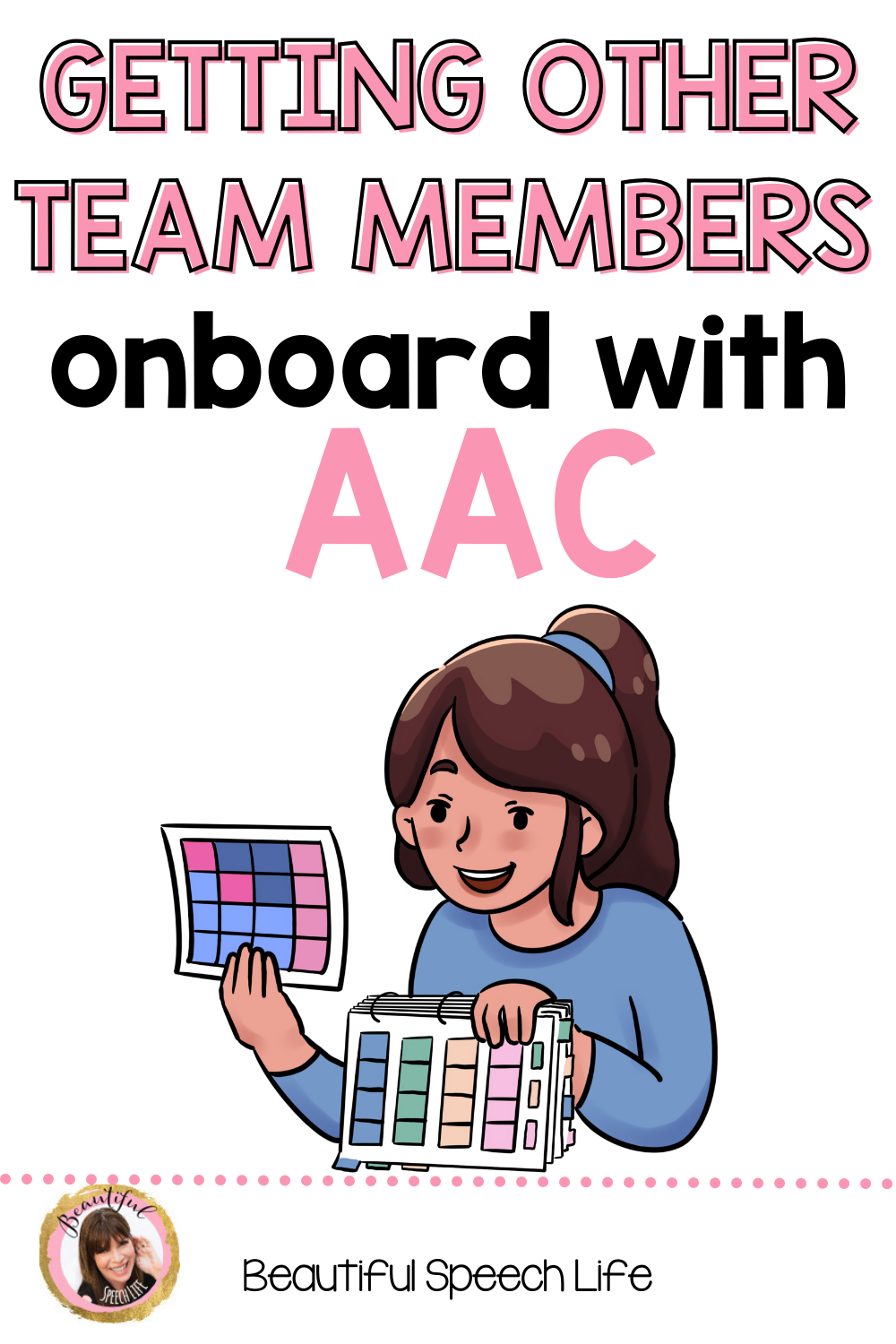
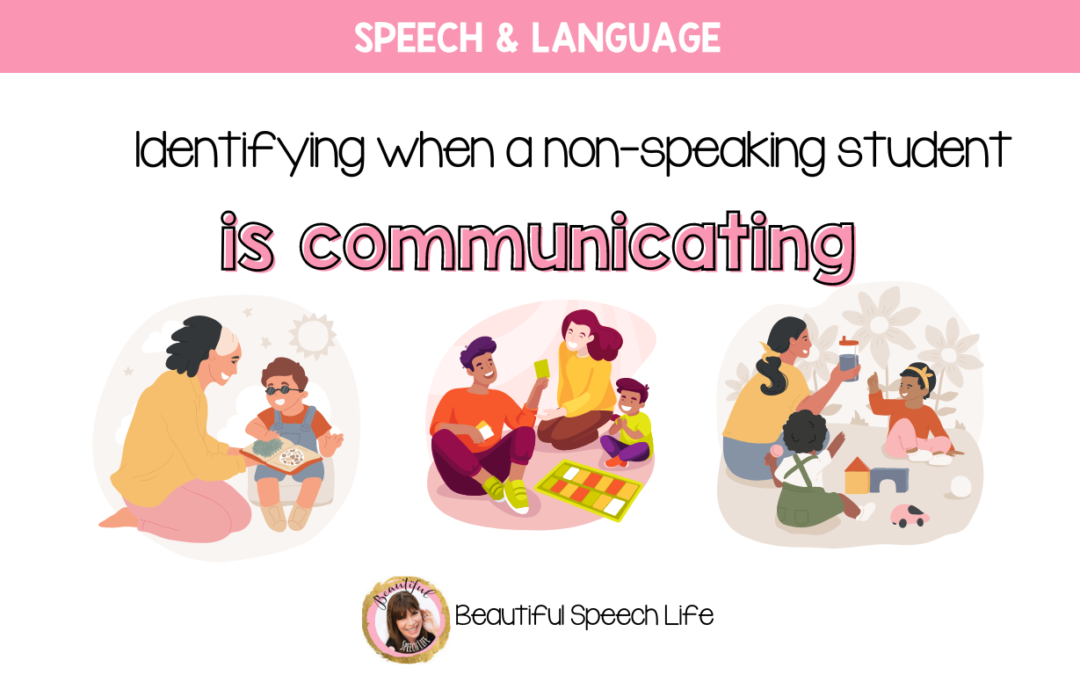
by Anne Page | Aug 26, 2023 | AAC, Quick Therapy Tips for the SLP and SLPA
Our goal as an SLP should always be to prioritize communication, rather than verbal speech. For each child to “say” what he wants to say, when he wants to say it. But it isn’t always easy to tell when a student is communicating with us.
When I first started working with students with significant cognitive disabilities, it was kind of scary because I didn’t know what to do when a student didn’t have a way to respond. Or at least I thought they didn’t have a way to respond.
As I’ve spent more time working with these students, I’ve learnt that they do have a way to respond. I just need to work out what that way is and use it to develop a system of communication that works for the student AND that more people in their environment can understand.
I learned that what you do is keep investigating and going back and trying things. Working to identify both speaking and non-speaking methods the student may be using to communicate.
Understanding the student’s baseline
One of the best ways I found to do this is to talk to the student’s family. Ask them things like, “How do you know when your child is uncomfortable?” or “What does he do when he is hungry?” Then you learn that there might be different cries, or that the child communicates he wants something by looking at it.
What we’re figuring out is the student’s baseline. Once we have that then the next step is working out how to build on it. We try to teach them a system of communication that we all understand – something that can take them throughout their lives.
With one student, we started noticing that he makes clicking sounds with his tongue and that means “I’m talking.” If you click back, he’ll click back. Now we’ve got a little conversation going on and we’re trying to build on that.
I also encourage you to share with your student’s parents and caregivers what they can do. Too often we are constantly telling parents and carers what their students can’t do. I share an example of how to do this in this Instagram post. In this example is a student I have who is starting to communicate by looking at people at they come into the room. I wanted to share with this student’s mother that there are things her daughter can do and that her daughter is starting to communicate.
And remember if you think a child may benefit from AAC, try it. There isn’t a need to wait. It won’t stop a child from developing speech. Actually, early implementation of AAC can help in the development of language and natural speech. (Romski et al., 2010; Luke, 2014; Wright, Kaiser, Reikowsky, & Roberts, 2013) It doesn’t need to be high tech. It can be as simple as a printed core board. You can get my Big Core Vocabulary Board here.
Looking to find out more about AAC? Learn more about my experiences with AAC in my interview with WIDA.
Pin to read later:
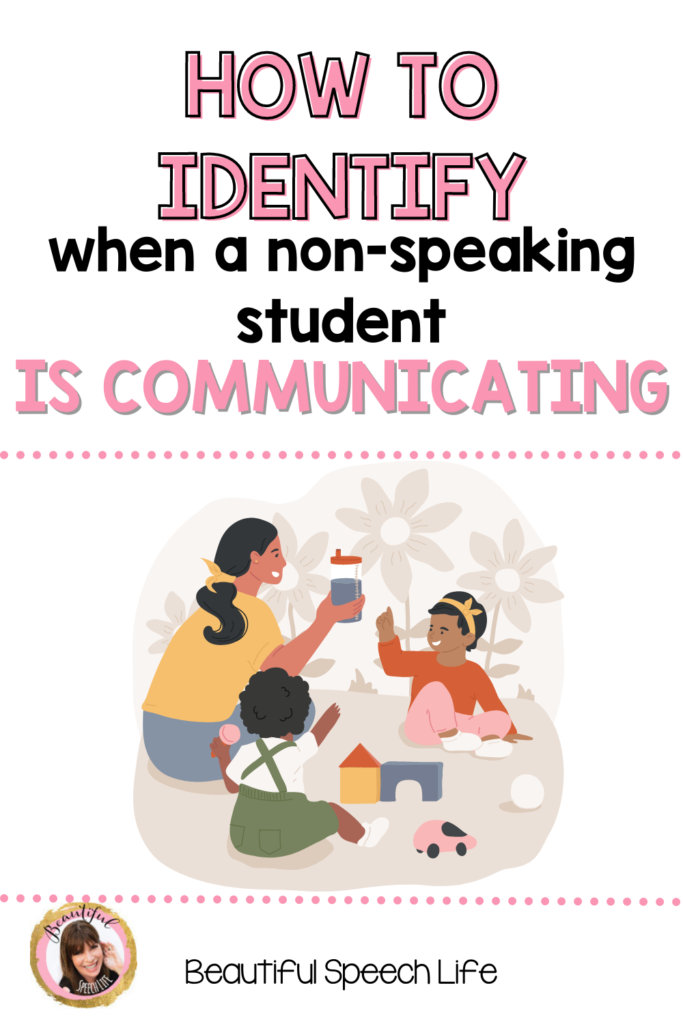
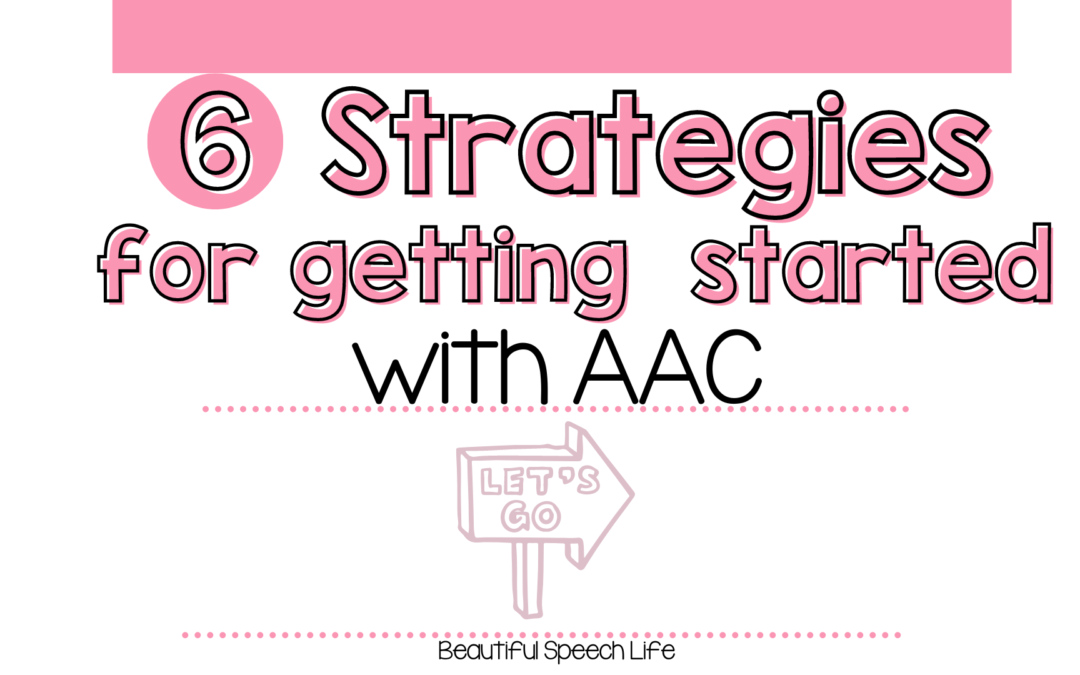
by Anne Page | Jan 31, 2023 | AAC
Augmentative and alternative communication (AAC) refers to a range of methods and tools that can be used to help people who have difficulty speaking or communicating effectively. (For more, read What is AAC?). But getting started with AAC can feel daunting. If you’re looking to help a child to get started with AAC, here are a few strategies to consider:
#1 Identify the child’s communication strengths and needs: It’s important to assess the child’s communication abilities and needs before choosing an AAC system. You should, if at all possible, work with a speech-language pathologist (SLP). SLPs are trained language experts and will be able to provide a full assessment. If you are somewhere where this isn’t possible, The Communication Matrix is an online assessment tool created to help families and professionals easily understand the communication status, progress, and unique needs of anyone functioning at the early stages of communication.
#2 Explore different AAC options: There are many different types of AAC systems available, including low-tech options like communication boards and high-tech options like speech-generating devices. It’s important to explore different options and choose one (or more) that are appropriate for the individual’s needs and abilities. If you are getting funding through Medicaid or insurance, it is common for these providers to require AAC trials on a minimum of three devices. Here are a few options to explore:
- Quicktalker Freestyle has a very informative website and they will help check if your insurance provider covers AAC.
- You can try low tech core communication boards. Pop over here to download my guide to core boards which includes links to popular AAC core boards. Additionally, here is a core board and farm themed activities.
- You can try the TouchChat app for free for 30 days: TouchChat Discover.
- Many AAC apps are on sale for ½ price in October for AAC Awareness month
#3 Involve the child in the decision-making process: It is important to involve the child in the decision-making process when selecting an AAC system. This can be as simple as using an AAC app during an activity, then trying a different app and then offering a choice between the two. This can help to ensure that the system chosen is one that they are motivated to use.
#4 Start small and build up: It can be overwhelming for both the individual and the communication partner to try to learn an AAC system all at once. It is often helpful to start with a few core words or phrases and gradually build the child’s communication skills over time. Choosing core words to use during activities that occur everyday is a great way to get started. A few examples:
- Brushing teeth: PUT on the toothpaste
- Getting dressed: PUT on your socks
- Going to school: let’s GO, time to GO to school
#5 Model, model, model: What is modeling? It’s you as the communication partner, using AAC to help the child learn AAC. You can learn all about it here. It takes time and practice to become proficient at using an AAC system. Think about how many times a baby hears the word “mama” before they say it. We’re building an understanding of language and a new way to communicate.
#6 Seek support, don’t do it alone: There are many resources available to help individuals and their families learn how to use AAC effectively. These may include speech-language pathologists, support groups, and online resources. Don’t be afraid to reach out for support if you need it.
If you would like ongoing support then come and join us in the AAC Academy. This membership-stye group AAC “coaching” program will build your SLP skills, increase your confidence, and allow you to help ALL of your students strengthen their communication skills.
Pin to read later:
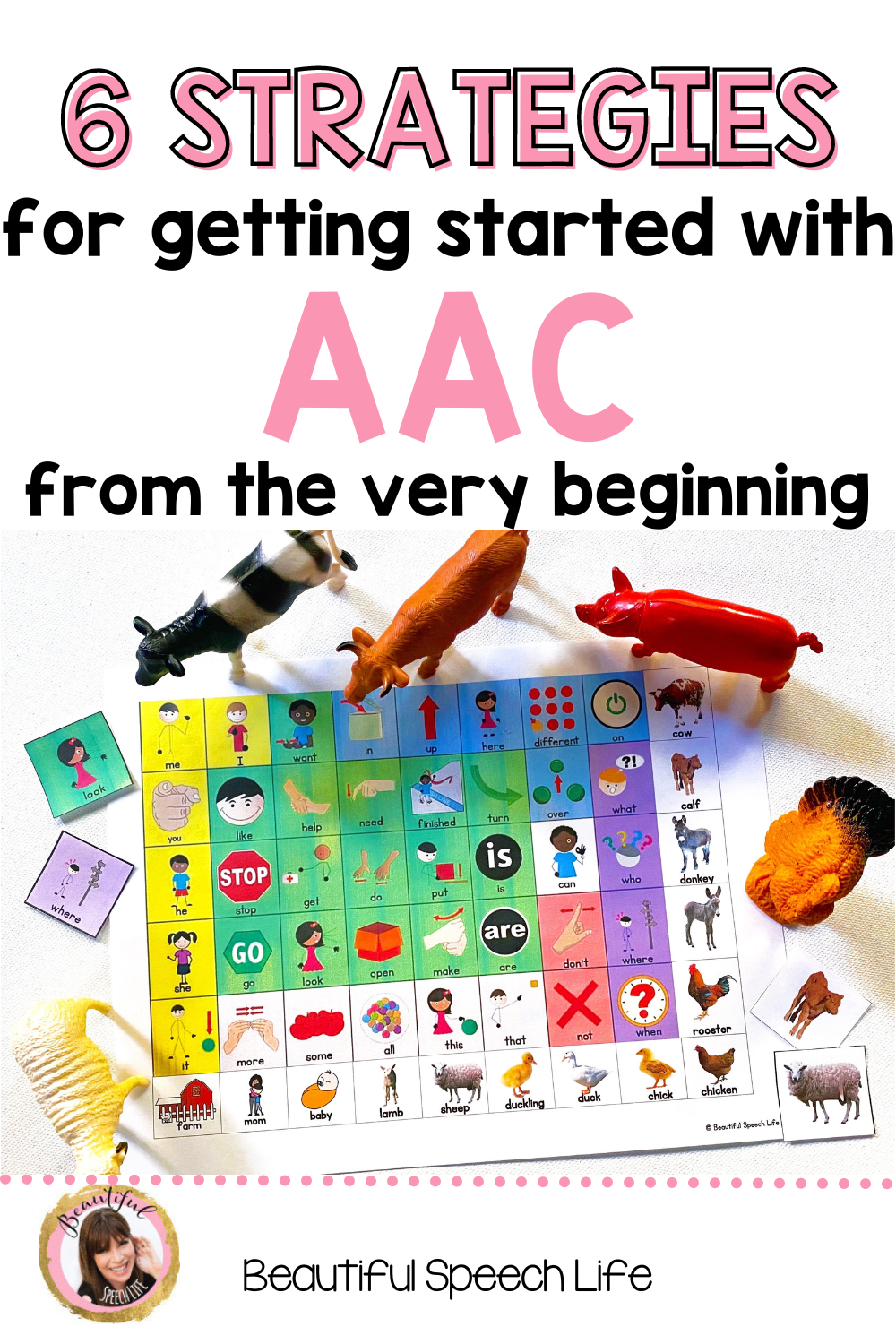











 Hey there I’m Anne Page. I help heart centered SLPs and educators put the fun in functional communication.
Hey there I’m Anne Page. I help heart centered SLPs and educators put the fun in functional communication. 